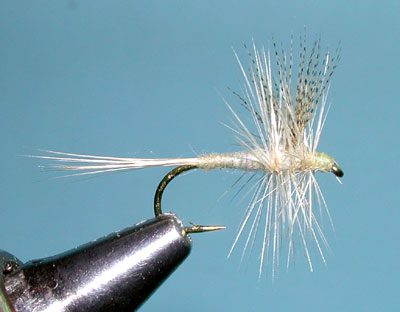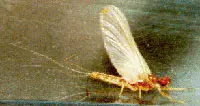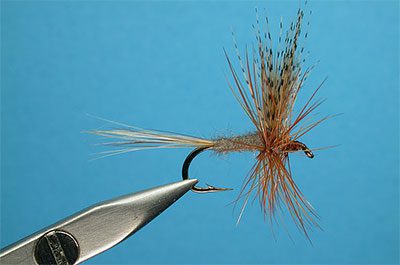Light Cahill – faith in nature to find a way

Light Cahill
| Materials
to Order Material, click the link |
|
|---|---|
| Hook | TMC 100, #12-20 |
| Thread | Uni-thread 8/0 Light Cahill |
| Body | Light Cahill Superfine |
| Tail | Light Ginger Spade Hackle Fibers |
| Wing | Dyed Mallard Flank Woodduck , upright and divided |
| Hackle | Light Ginger |

Light Cahill
Dan Cahill of Port Jervis, N.Y. was a brakeman on the Erie and Lackawana Railroad in 1884. He was working in the Catskills on a hot and humid day. On board was a can of brood Rainbows destined for the Caledonia fish hatchery in upstate New York. A work train derailed in front of his train and Cahill knew that the brood Rainbows would perish in the mid-summer heat.
Catskill Rainbows
Dan convinced his fellow crew members to help him take the heavy can of trout back to Calicoon Creek so that they might survive. The distance was a good mile but the trout not only survived but flourished with that little Catskill stream. As nature has a way, the offspring of that planting eventually spread throughout the Hudson River watershed. To this day, the ancestors of Cahill’s efforts provide some of the finest rainbow trout fishing in the east. Edward Hewitt was a fishing companion of Cahill and often told this story to his friends so that Cahill’s name remained within the lore of fly fishing history.
Cahill Fly
However, Cahill’s name is known to us from the fly pattern he designed. Ray Bergman wrote in Trout (1938), about the Cahill fly, “If it was necessary to confine my assortment of flies to only two or three, this would be one of them.” To many it is an Eastern fly but it has also found success in the Midwest, the Mountain states, and the Sierra of California.
Dark Cahill
The Dark Cahill is the pattern that was most often tied by Dan and may have been the only pattern variation of the Cahill series that can be cited directly to Dan. He used it with great success on Brook trout. Rau Bergman considered the Dark Cahill to be a “particularly killing fly” pattern in his book “Trout” (1938). The sample presented was tied by Alan Podell and is from Han’s Weilenmann’s Fly Tiers Page
Light Cahill
Theodore Gordon is often credited with creating the lighter version and altering the pattern as a wet fly. The light Cahill has gone through many transitions from a Ginger, to Cream, to Yellow, to White, and is thought to imitate the family of mayflies, Stenonema.
Variations

Dark Cahill
| Hook | TMC 100, sizes 14-16 |
| Thread | Uni Thread 8/0 Brown |
| Body | Gray Muskrat |
| Tail | Ginger Spade Hackles |
| Wing | Dyed Mallard Flank Woodduck , upright and divided |
| Hackle | Ginger Hackle |
